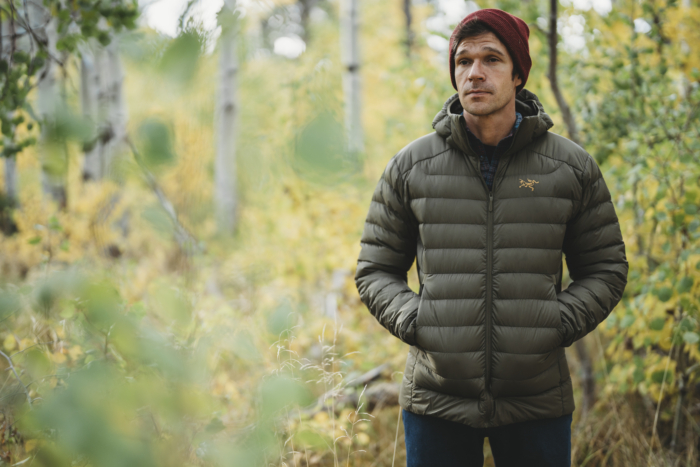Looking for the best down jackets for hiking, backpacking, camping, or everyday wear? Over the past five years, our expert team tested more than 50 puffies to find the warmest, comfiest, and most adventure-ready options.
Current authors Ryan Kempfer and Chris Kassar have donned over 20 models on a range of wild escapades in the past year alone. From snowy alpine ascents in the Tetons to chilly windblown nights on Colorado fourteeners to dog walking and snow shoveling, we put these jackets to the test worldwide in almost every environment imaginable.
Our top pick is the Arc’teryx Cerium Hoody because it offers the ideal balance of performance, weather protection, durability, and warmth. For a true value, the REI Co-op 650 Down Jacket delivers warmth and style in a simple, affordable package. Whether you’re looking for a technical piece or one suited for strolling around town, we have you covered.
Editor’s Note: We updated our Down Jacket Buyer’s Guide on July 20, 2025, by revising all reviews based on further testing, adding fit and relative warmth information to each review, and updating our purchasing advice to make it more helpful.
The Best Down Jackets of 2025
Best Overall Down Jacket
9.5/10 Rating
Best Budget Down Jacket
7.0/10 Rating
Most Versatile Down Jacket
8.9/10 Rating
Most Durable Down Jacket
9.1/10 Rating
Best Down Jacket For Big Days Above Treeline
8.2/10 Rating
Best Down Jacket for Backpacking
8.4/10 Rating
Best Down Jacket for Hiking
8.5/10 Rating
See more picks
Best Overall Down Jacket
-
Hybrid insulation design is helpful in wet weather -
Solid warmth-to-weight ratio -
Comfortable, stylish fit
-
Expensive -
No integrated stuff sack
Best Budget Down Jacket
-
Affordable -
Quite durable given the price -
Simple and sleek design looks good around town
-
Somewhat heavy for the lack of features -
Not much adjustability
Most Versatile Down Jacket
-
Simple, classic style -
Comfortable fit -
Includes an adjustable hood and hem -
Includes 5 total pockets
-
On the heavier side for a technical piece
Most Durable Down Jacket
-
Extremely durable -
No stitches or glue to degrade or restrict movement -
Sheds water and resists winds like no other -
Versatile -
Zippered hand and chest pockets -
Super stylish
-
Not as packable as others
Best Down Jacket For Big Days Above Treeline
-
Incredibly ultralight -
Very packable -
Impressive warmth in small package -
Pullover style works well
-
Expensive for such a specific jacket -
Delicate outer fabric -
No pockets
Best Down Jacket for Backpacking
-
Lightweight & packable -
Comfortable -
Perfect fit -
Stellar warmth-to-weight ratio -
Solid weather-resistance
-
Needs more pockets -
Too warm for high-output activities
Best Down Jacket for Hiking
-
Stellar warmth-to-weight ratio -
Packs down ridiculously small -
Ultralight
-
Cuffs aren’t elasticated, making it hard to seal in warmth -
Somewhat boxy fit in the torso
More Down Jackets That Deliver
-
Excellent warmth-to-weight ratio -
Ultimate mobility -
Keeps you warm when slightly wet -
5 well-placed generous pockets keep necessities accessible -
Packable -
Extremely comfortable
-
Slim fit makes layering underneath difficult -
Soft outer material raises durability concerns -
Pricey
-
Responsible Down Standard (RDS) certified down -
Five pockets: two external hand pockets, chest pocket, dual internal stash pockets
-
Cozy but not built for supreme warmth
-
Superior warmth-to-weight ratio -
Anatomical shape that allows the jacket to move with you during activity -
Durable
-
Hood is pretty large and floppy unless you are wearing a helmet
-
Comfortable, soft to the touch -
Stylish -
Perfect fit -
Versatile uses -
RDS-Certified Down
-
Soaked up more water than others -
Average warmth for the weight -
Outer fabric showing wear and tear with little use
-
Large baffles hold more heat -
DWR repels wet snow -
Outer materials resist abrasions, cut wind -
Insulated hood with high neck protects face -
Big durable zippers you can grab with gloves
-
High price tag -
Hem length felt short/skin exposed with certain movements
-
Reasonable price point -
Silky soft to the touch -
Very comfortable -
Packable
-
Lack of mobility limits movement in activities like climbing or scrambling -
Wets out quicker than others
-
Best-in-class warmth-to-weight ratio -
900 fill-power down is treated with Nikwax hydrophobic finish -
10-Denier Pertex Quantum outer shell has DWR finish -
Two-way front zipper -
Includes stuff sack
-
Tight fit in midsection due to aggressively tapered waist -
No inner pockets -
Pricey
-
Packs into its own pocket -
Increased bust circumference on women’s jacket for improved fit -
20-denier ripstop nylon liner
-
Not premium construction for rugged outdoor play
-
Great warmth-to-weight ratio -
Trim fit but can still layer underneath -
Durable design
-
No internal drop-in pockets -
Separate stuff sack to keep track of
The Best Down Jackets Comparison Chart
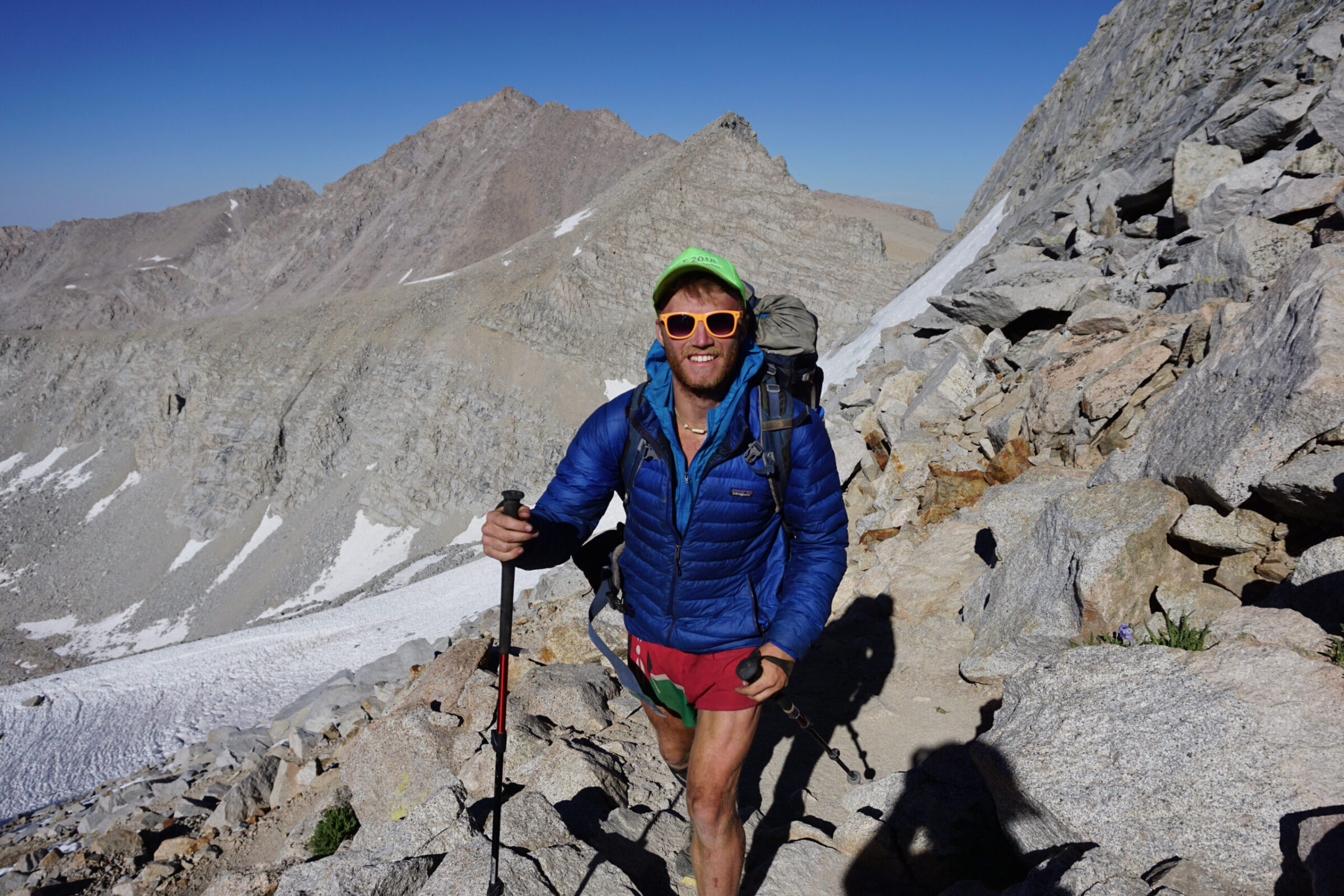
How We Tested the Best Down Jackets
Our team has tested, reviewed, and published down jacket Buyer’s Guides across several seasons. For this guide, we considered the most durable, highly acclaimed, well-constructed, and environmentally responsible down jackets. These layers are made for a variety of conditions and present a range of prices.
Our Expert Testers
Editor-in-Chief Adam Ruggiero led the charge in curating and testing our initial lineup of over 20 down jackets in 2020. A seasoned, well-rounded outdoorsman, he knows what to look for in the insulation he depends on in the backcountry and used his years of experience to lay the framework for this comprehensive guide.
Senior Editor Chris Carter took the reins of this guide in August 2022 and has been sifting through mountains of these puffy layers ever since to bring you the streamlined selection you see today. He left no feather unturned. A long-distance thru-hiker and rock climber at heart, he tested countless down jackets in every concoction of conditions imaginable and won’t settle for anything but the best on his escapades.
In spring 2024, Lake Tahoe resident Nick Bruckbauer contributed his testing experience to this guide, adding two new lightweight models that he tested on fast and light hikes in the Tahoe backcountry, chilly forest and neighborhood walks and runs, and while shoveling and plowing Tahoe’s famous Sierra Cement snowfall. In 2025, along with editor Chris Kassar, Ryan Kempfer, an avid backcountry skier, hiker, biker, and overall gear nerd, took over this guide and added jackets he had tested in the Tetons and Rockies high country.
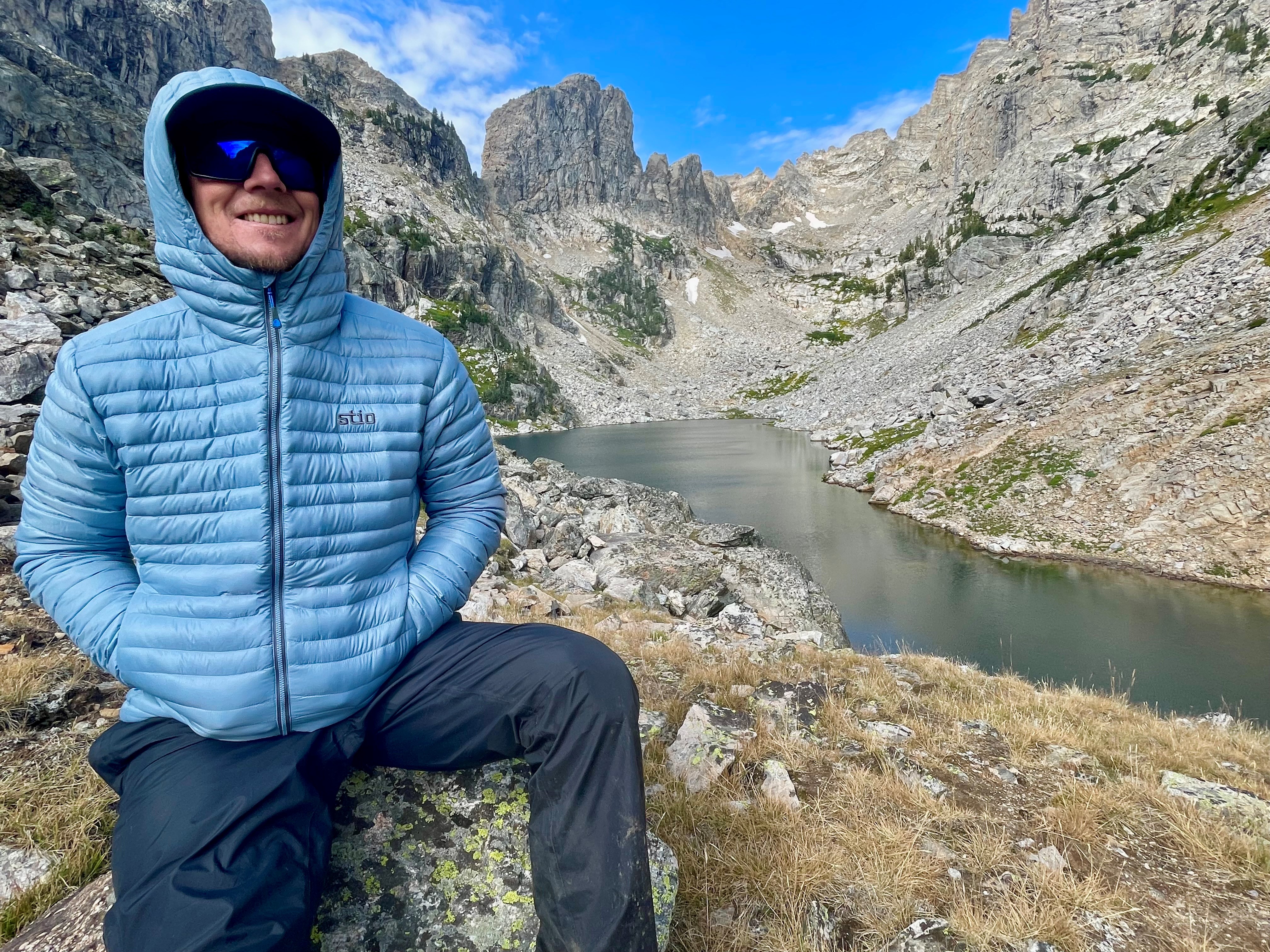

Our Testing Grounds & Process
To challenge and determine the top designs, we enlisted a number of other staff authors and editors to get as diverse a perspective as possible, and test these puffies across a broad range of outdoor pursuits. Our testers donned these jackets in all seasons, from snowy environments in the Rockies, to chilly big wall ascents of El Cap in Yosemite.
The crew has used these jackets for camping and urban commutes, as well as alpine and rock climbing, backcountry skiing and splitboarding, bikepacking, and alpine skiing. The testers ranged from AIARE-certified backcountry venturers to lifelong recreationists.
Finally, this is an organic, constantly evolving guide. We work hard to stay on top of new trends and novel technologies and closely examine updated jackets and new models the moment they hit the market to bring you the most up-to-date choices possible. If you’re looking for women-specific recommendations, check out our guide to the best women’s down jackets. If you’d prefer something better for wet climates, check out our guide to the best synthetic insulated jackets, or if you’re in the market for something cozy, check out our guide to the best fleece jackets.
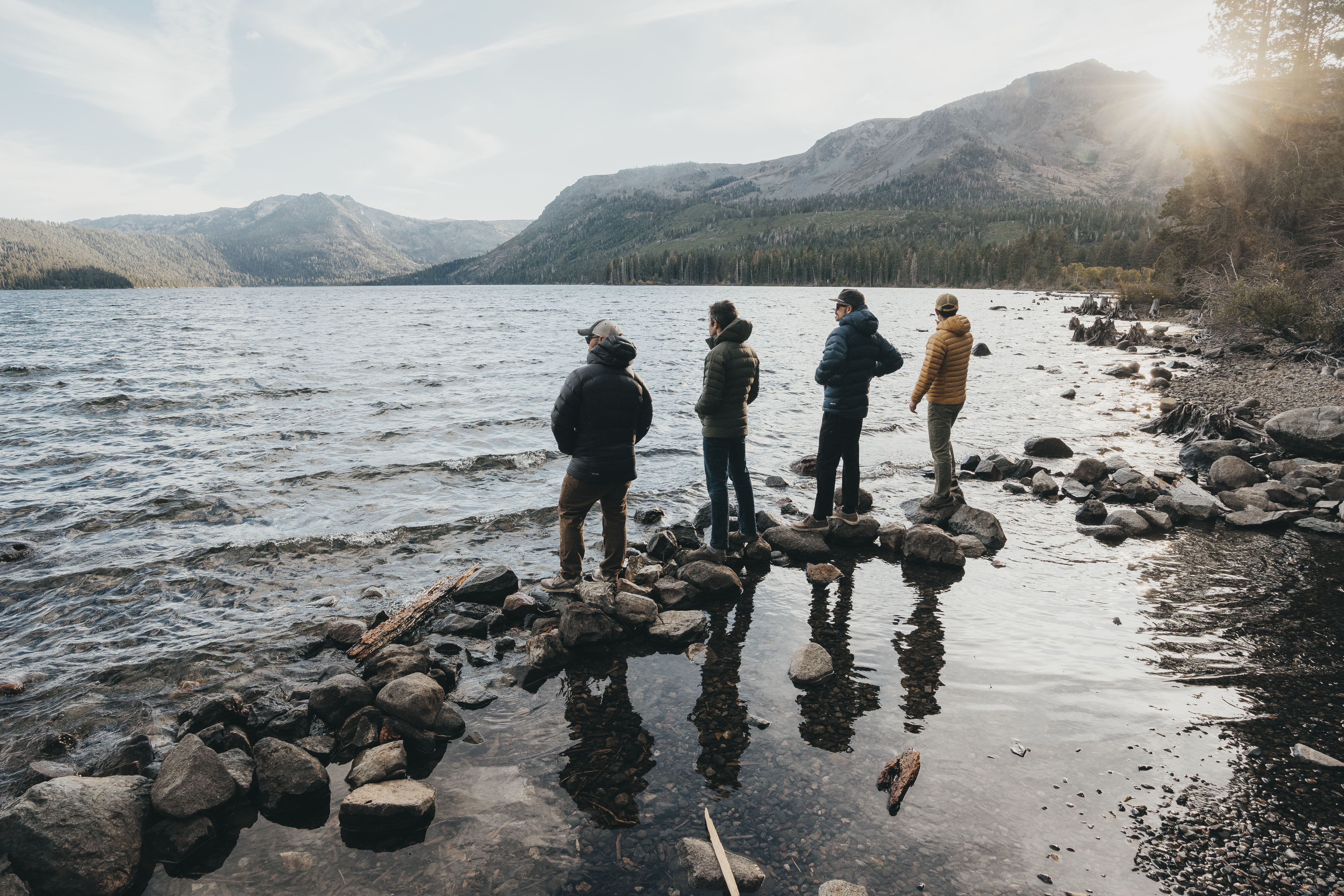

Buyer’s Guide: How to Choose the Best Down Jacket
You can also check out our expanded list of the best down jackets for women.
Understanding Down Warmth: Fill Power vs. Fill Weight
Unlike sleeping bags, down jackets don’t come with standardized temperature ratings, which makes comparing warmth tricky. Most people are familiar with fill power, a measure of down quality and loft, but fill weight is just as important when it comes to real-world warmth. There are certainly other factors that contribute to a down jacket’s warmth, like baffle shape, design, construction, jacket materials, size, fit, and other features like hood, hem, or cuff closures. All things being equal, however, the down fill power and fill weight will have the most direct impact on a jacket’s warmth.
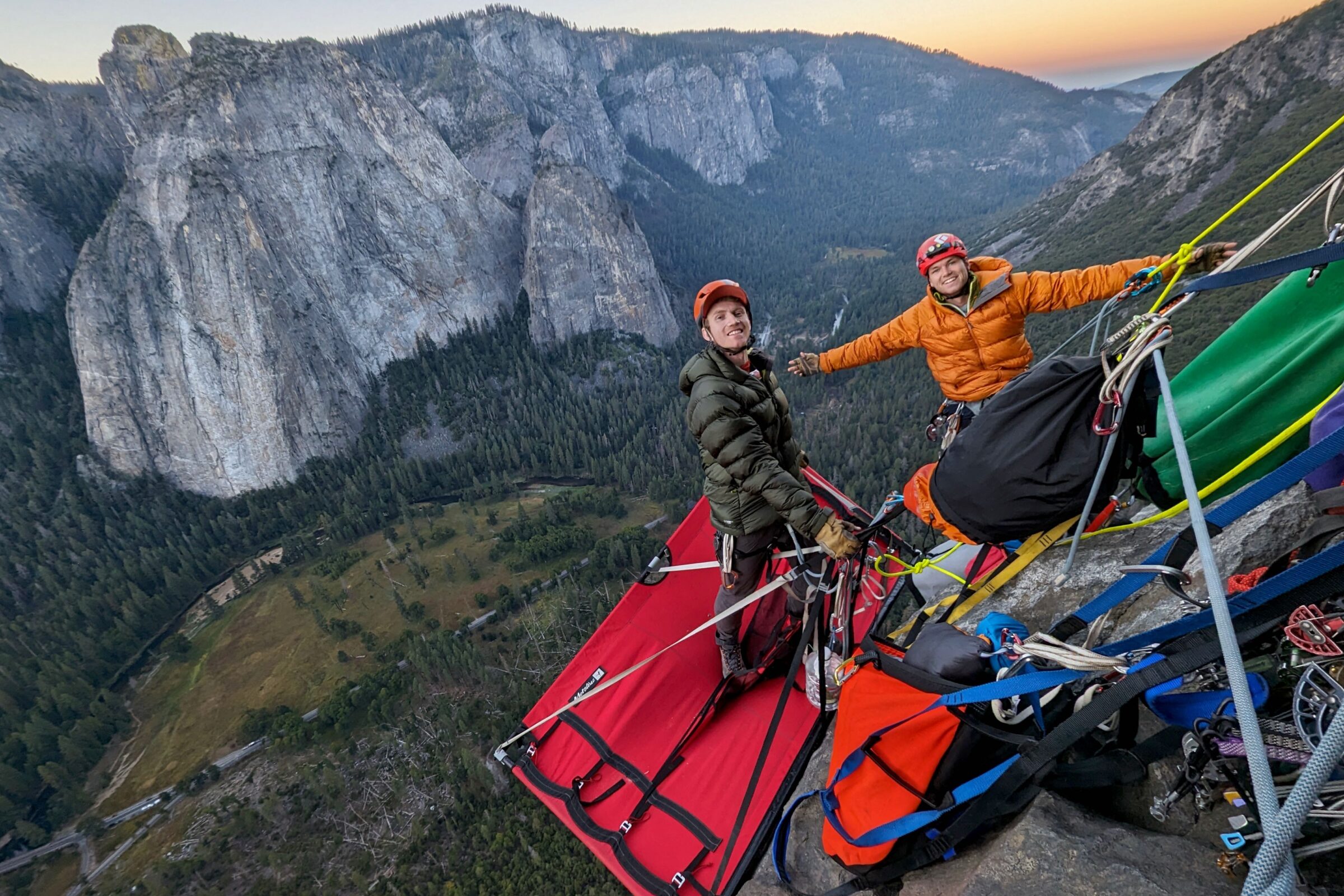

Fill Power
Fill power measures the loft of down in cubic inches per ounce. Higher fill power means fluffier, lighter, and more compressible insulation:
- 400–500: fair
- 600: good
- 700: great
- 800: excellent
- 900+: premium
Higher fill power traps more air per ounce, offering better warmth for less weight. But, fill power is only part of the equation.
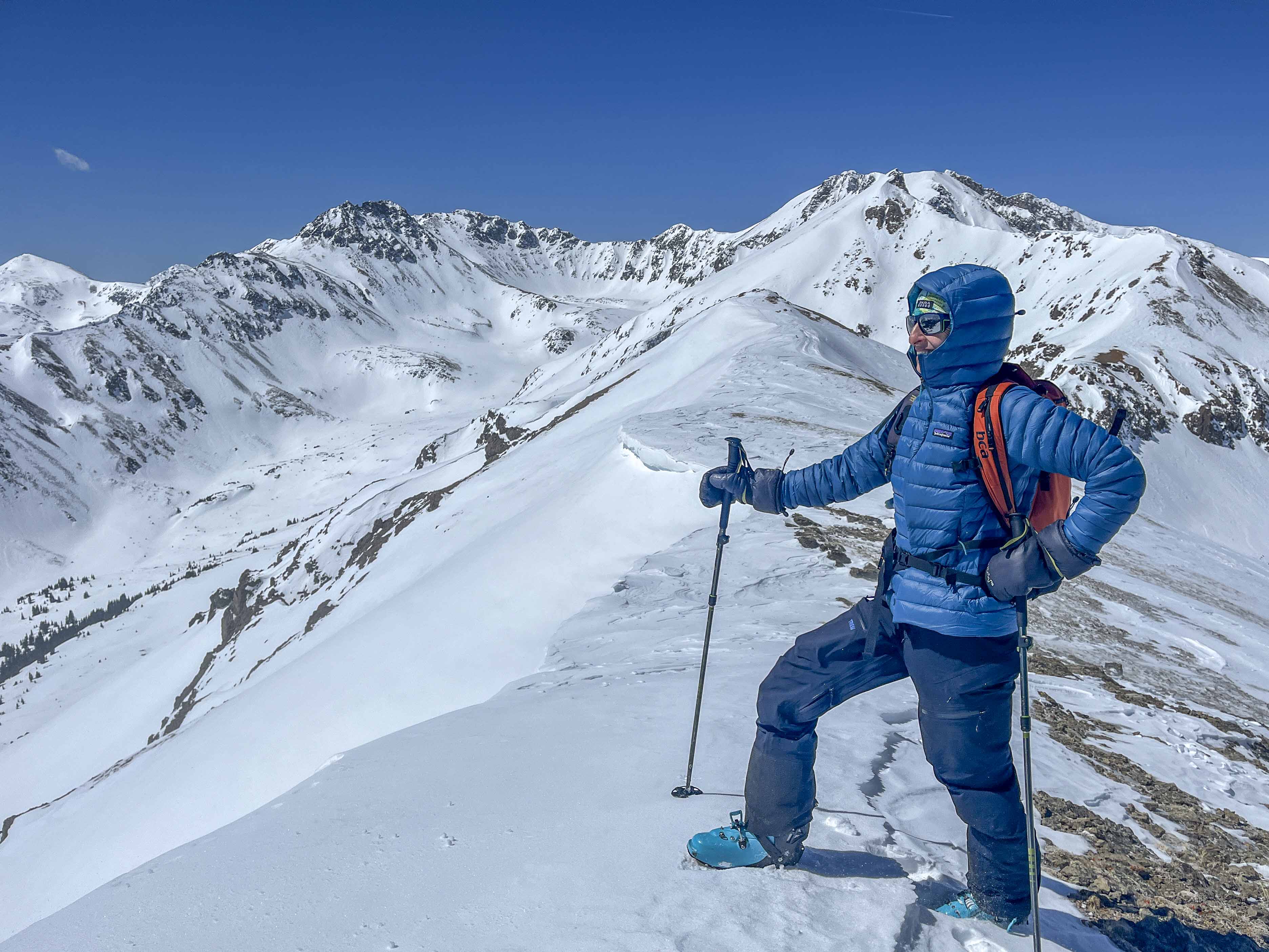

Fill Weight
Fill weight is the total amount of down inside the jacket, measured in ounces or grams. To get a reasonable estimate of a jacket’s overall warmth, you can multiply the down’s fill power (expressed in cubic inches per ounce) by the jacket’s fill weight (expressed in ounces), which will yield a number that represents the three-dimensional volume of the jacket’s insulation, or loft, in cubic inches.
On paper, we can, therefore, estimate that the Patagonia Down Sweater Hoody (5.3 ounces of 800-fill-power down) will be warmer than the Feathered Friends Eos (4.0 ounces of 900-fill-power down). Even though the Eos has a higher fill power of 900, the Down Sweater has a higher fill weight of 5.3 ounces.
Patagonia Down Sweater Hoody: 800 cubic inches per ounce x 5.3 ounces = 4,240 total cubic inches of insulation
Feathered Friends Eos: 900 cubic inches per ounce x 4.0 ounces = 3,600 total cubic inches of insulation
While the Eos uses higher quality down, the Down Sweater is warmer overall due to more insulation.
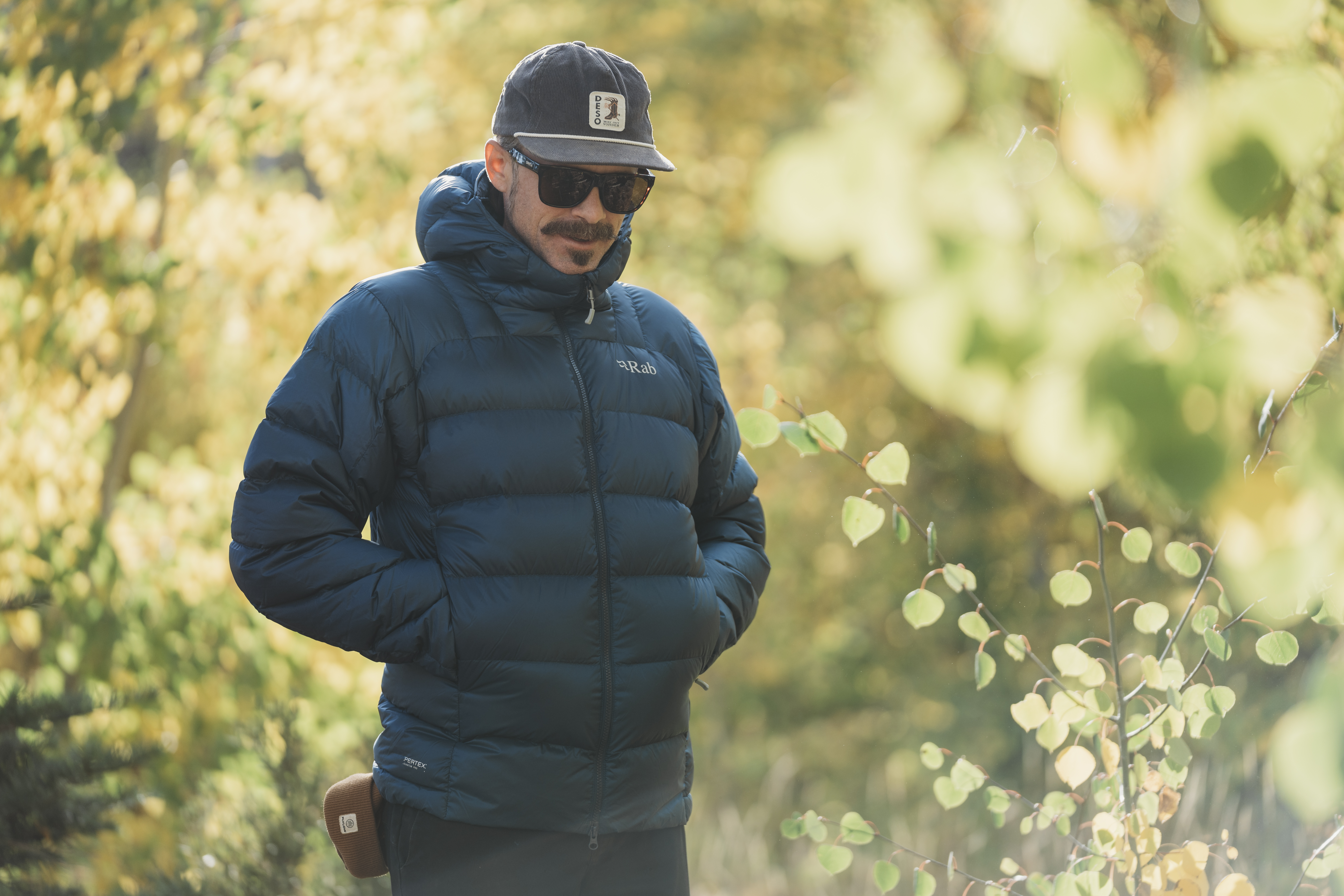

Warmth-to-Weight
The Eos is lighter (10.8 vs. 15.0 ounces), so it offers a better warmth-to-weight ratio. But if you’re prioritizing warmth alone, especially for long belays or cold alpine starts, heavier jackets like the Rab Neutrino Pro (7.5 ounces of 800-fill down) are the way to go.
Lighter jackets like the Mountain Hardwear Ghost Whisperer (3 ounces of 800-fill, total weight 8.8 ounces) are great for fast-and-light missions but fall short in prolonged cold or when you’re standing still.
Fill weight isn’t always advertised as readily as fill power. But, fill weight is — in our opinion — a much more crucial stat to consider when gearing up for any adventure. While other factors, such as face fabric, sewn-through seems versus box baffles, and other features, play a role in how warm a jacket is, a higher fill weight will almost always indicate a toastier puffy. Note: We would like to include fill weight in our specifications for each product, but have found it challenging to find for most products, even when asking brands.
Bottom line: Fill power tells you how efficient the down is. Fill weight tells you how much insulation you’re actually getting. Together, they’re your best indicators of how warm a jacket will be.
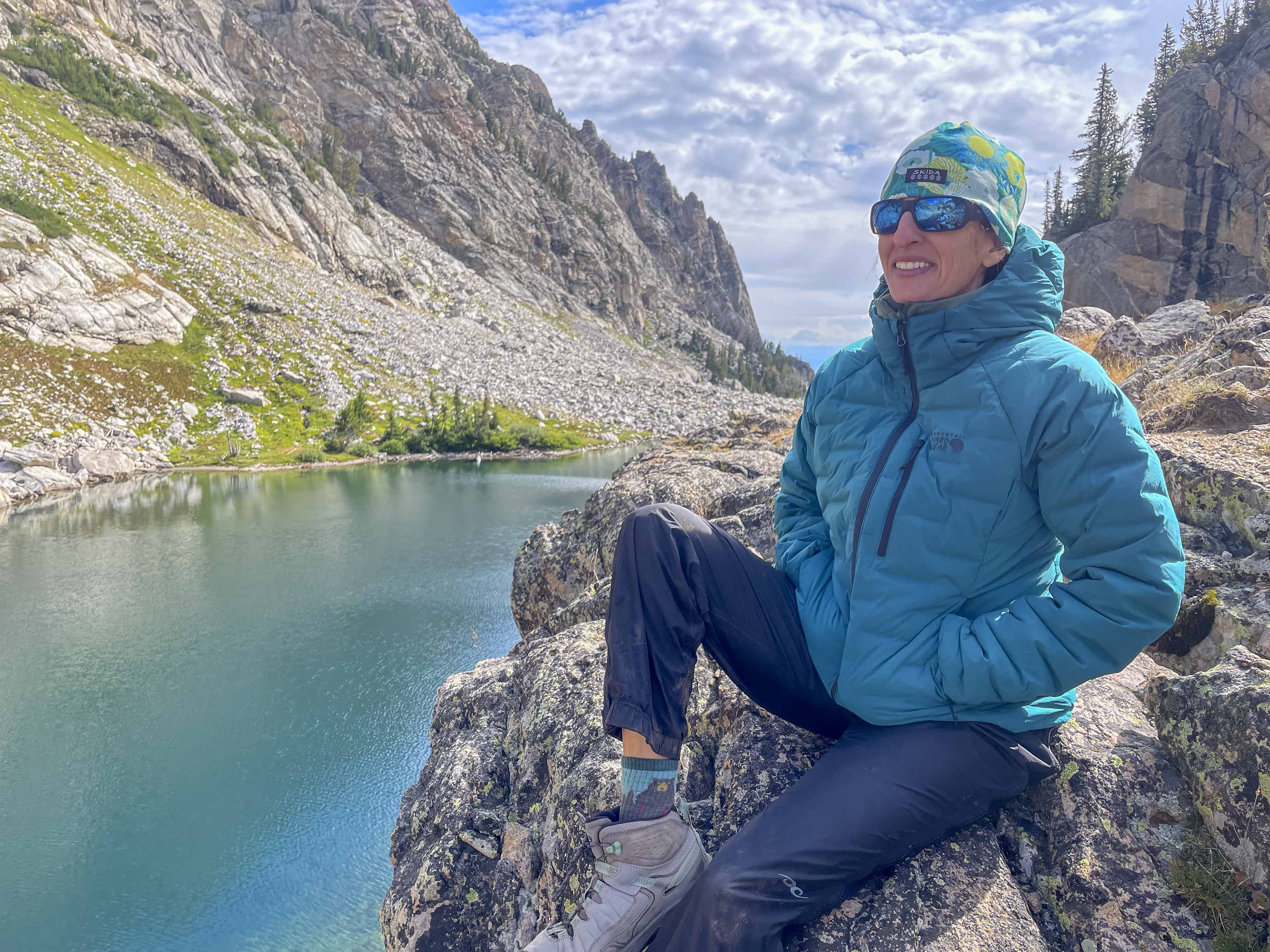

Durability
The shell fabric is an important factor for both durability and packability. Ultralight jackets tend to be made with a lighter, thinner shell material. Denier is the measurement used here. A lower denier rating means the outer fabric is lighter and, therefore, more prone to tears.
For backcountry excursions, the lower weight can be a worthy tradeoff. But for daily use, we recommend a higher denier like we see in the Mountain Hardwear Stretchdown Hoody. Most of the jackets we tested have a 10-denier or 20-denier shell fabric, with some 30-denier models. And if you do get a tear or campfire burn hole, there’s always the reliable duct tape, Tenacious Tape, or Noso Puffy Patch repair options.
Most of the jackets we tested have a 10-denier or 20-denier shell fabric, with some 30-denier models.
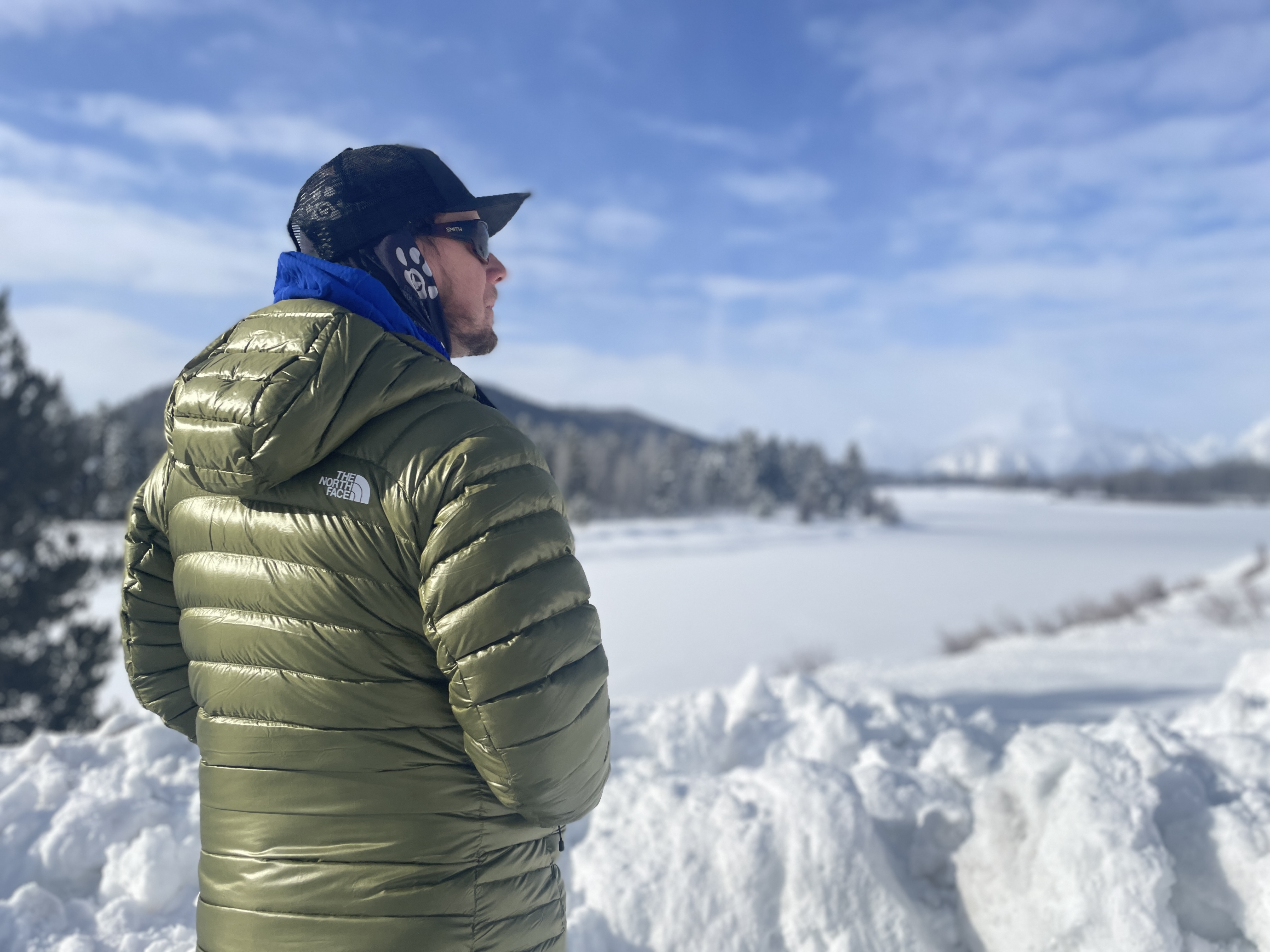

Water Resistance & Hydrophobic Down
Down does not perform well when wet. And this is one of the places synthetic jackets tend to win out. In the past decade, there has been a growing use of hydrophobic down. Essentially, the down feathers are coated in a water-resistant polymer. It still doesn’t match the water resistance of synthetics, but for light precipitation, hydrophobic down like the kind used in the Black Diamond Approach Hoody can’t be beaten.
Manufacturers treat the face fabrics of some jackets like the Patagonia Fitz Roy Hoody and the Patagonia Down Sweater Hoodie with DWR to help block light moisture, too. Our pick for the most weather-resistant down jacket, The North Face Summit Series Breithorn Hoodie, has both water-resistant down and an outer made of recycled nylon that has both a DWR coating and Pertex Y Fuse, which increases the down-proof and water-beading properties of the fabric.
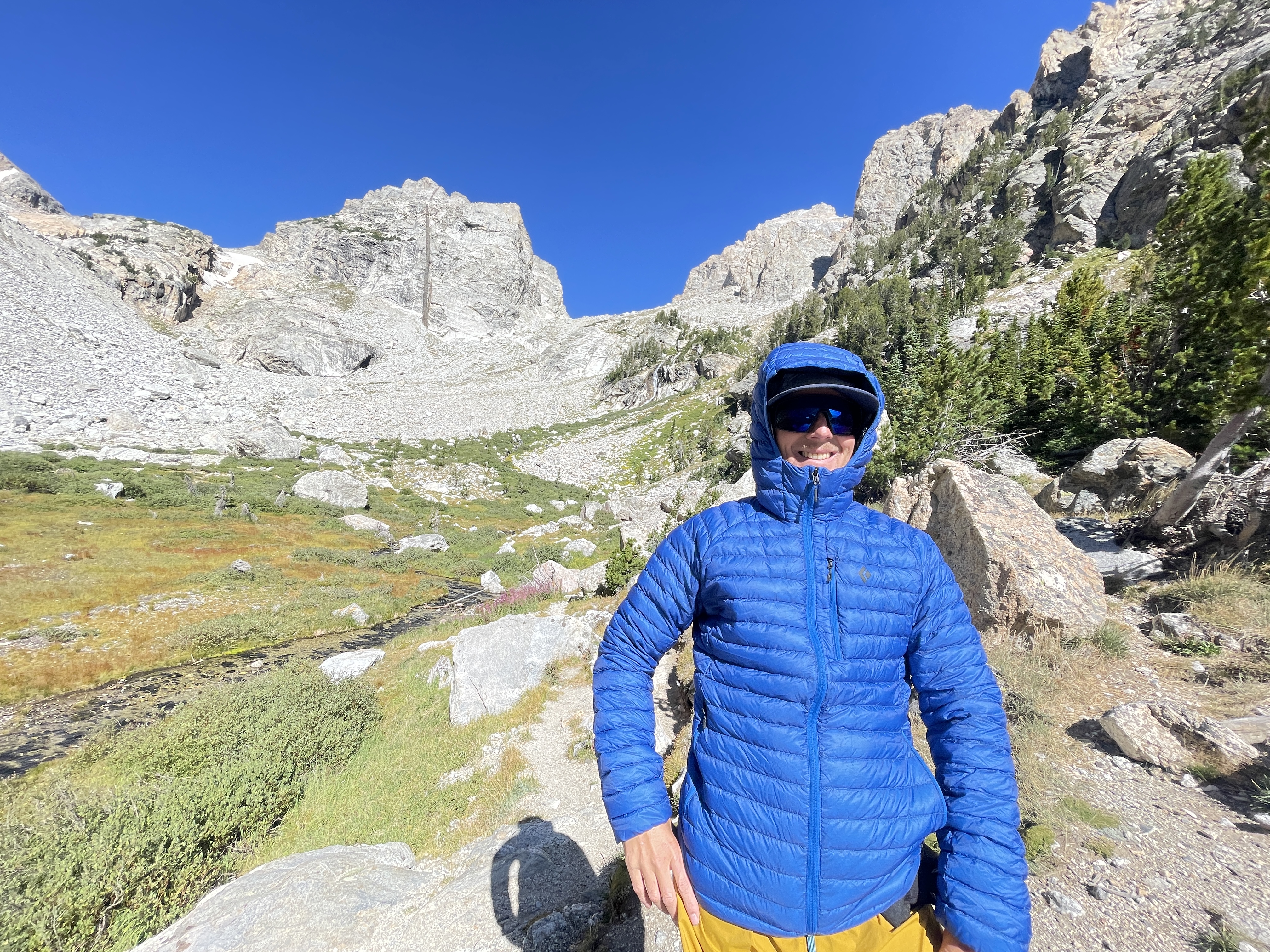

Fit: Finding the Right Jacket for the Job
The way a down jacket fits should match how you plan to use it. Some are trim and athletic for layering and mobility, while others are boxier or longer for casual use and added coverage.
Technical Pursuits
For technical pursuits like climbing, ski touring, or alpine travel, a trim, athletic fit works best. Jackets like the Rab Mythic Alpine and Black Diamond Deploy Down Hoody are designed with movement in mind. The Mythic Alpine fits close to the body but still allows room for a midlayer, making it perfect for backcountry missions and high-alpine backpacking. The Deploy Hoody is even more minimal, incredibly light, and form-fitting; it shines on fast-and-light peak pushes where every ounce matters. The ultralight Mountain Hardwear Ghost Whisperer is ideal for day hikes where you don’t want a ton of added weight, but need the protection of an extra layer.
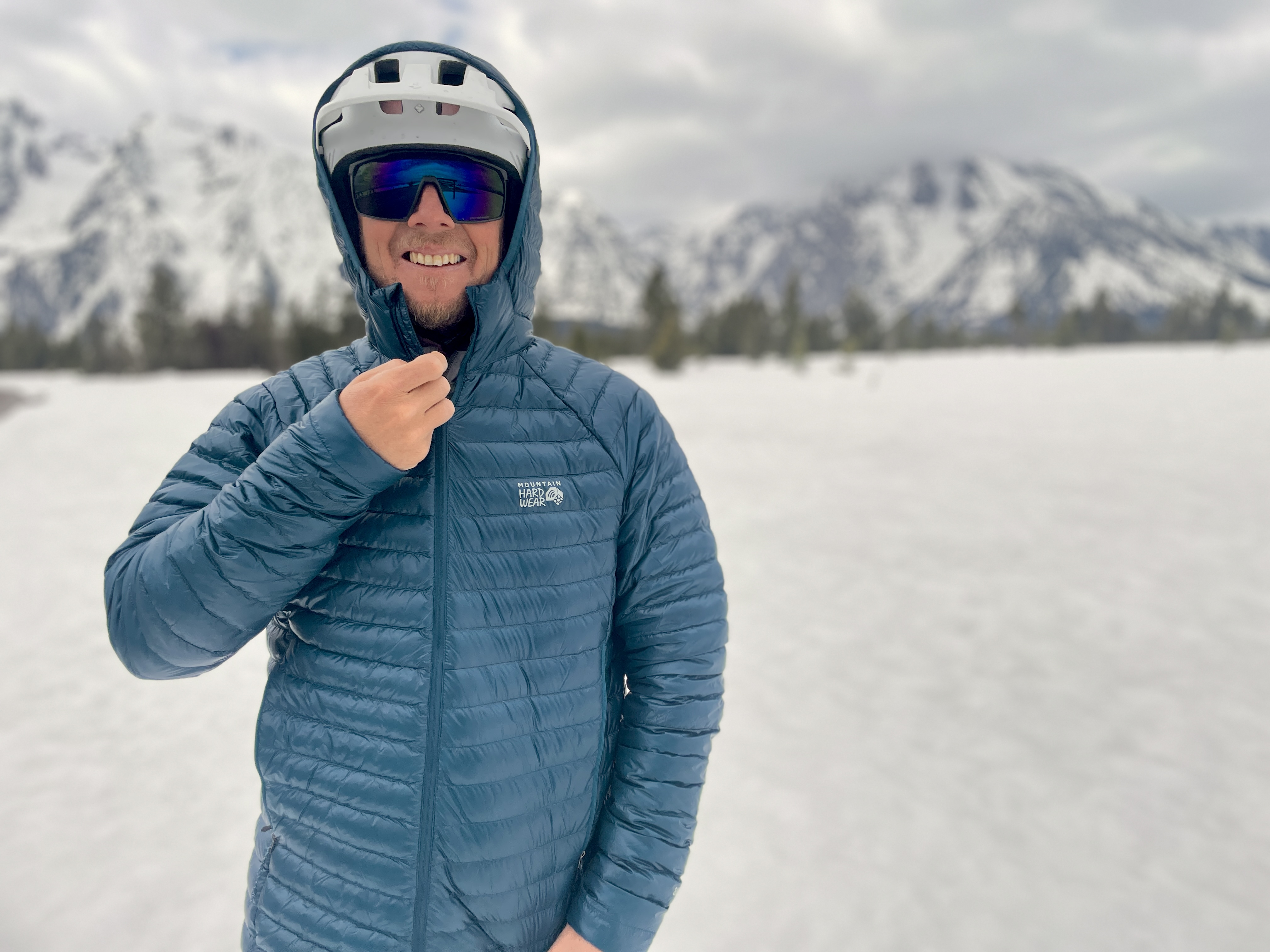

If comfort and mobility are a priority, the Mountain Hardwear Stretchdown Hoody stands out. With its flexible fabric and more forgiving cut, it moves effortlessly through big reaches, shoulder rotations, and scrambles. It’s ideal for hiking, climbing, and everyday wear where breathability and freedom of motion matter.
Trail-to-Town
For more casual use or mixed urban-to-trail wear, the Outdoor Research Transcendent Hoody and Stio Pinion Down Hoody offer relaxed fits with solid warmth and style. Both look good enough to wear around town but are built to handle shoulder-season hikes or winter campouts. The Patagonia Down Sweater Hoody also nails the balance, as it is more fitted than previous versions but still roomy enough to layer, and works equally well on snowy trails or under a shell at the resort.
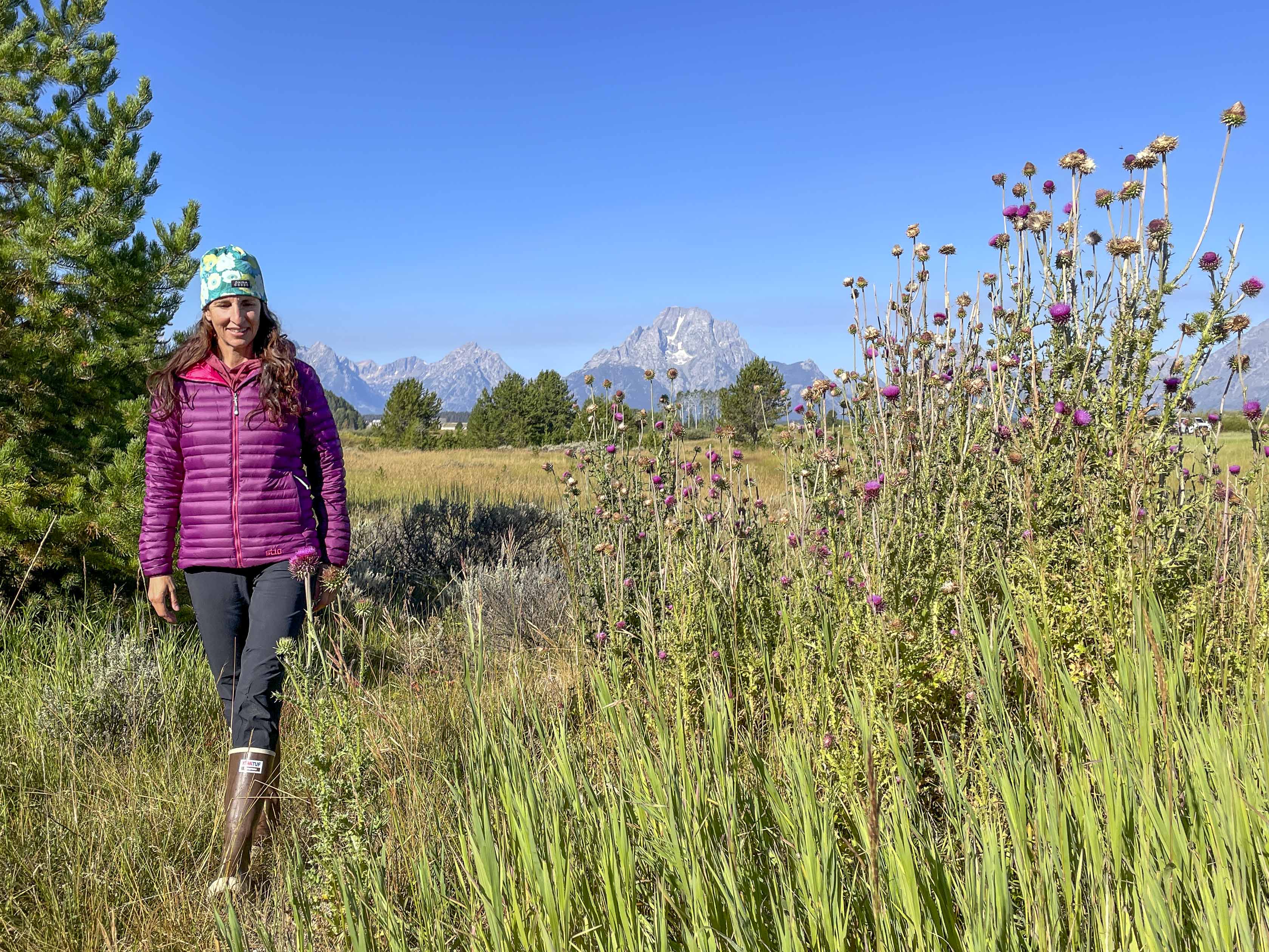

If you’re looking for maximum warmth and space to layer underneath, the Rab Neutrino Pro delivers. It has an expedition-ready fit with extra room in the torso and arms, making it a great belay jacket or outer layer in truly frigid conditions. On the flip side, the Arc’teryx Cerium Hoody has a much trimmer fit, ideal for high-output activities or minimal layering.
Why Fit Matters
Fit also impacts warmth. A jacket that’s too loose will let heat escape, while one that’s too tight might compress the down and limit mobility. Try to find the sweet spot for your body type and activity level, and if in doubt, check whether the jacket is designed as a midlayer, outer layer, or standalone insulator. Whether you’re hiking ridgelines, commuting by bike, or sipping coffee after a tour, choosing the right fit makes all the difference in comfort and performance.


Down vs. Synthetic
Most of the jackets in this guide are made with down, though a handful are filled with synthetic insulation that mimics down or a blend of the two. For example, both Arc’teryx models we tested, the Cerium and the Thorium, use synthetic insulation in places that tend to get wet, so they stay loftier and keep you warm even when you get wet.
Synthetic insulation, on the other hand, is made from polyester fibers and designed to imitate down clusters and properties with a few key differences. If you compare two jackets of equal weight, down is warmer than this alternative. But synthetic insulation retains warmth even when wet. It’s also easier to wash and usually comes at a lower price point.
- Pros of down: Excellent warmth-to-weight ratio, comfort, compressibility, lightweight, high inherent warmth
- Cons of down: Inability to insulate when wet, not super breathable, more difficult to wash, pricier


Within synthetic jackets, active insulation is another progressive subcategory to know. These technical garments are designed to dump extra heat and dry fast, so you don’t have to remove the jacket during vigorous activity. But these layers need also to be durable, warm, and wind-resistant. It’s a tricky balance.
Overall, synthetics can be a better, safer choice in wet or mixed weather and when weight isn’t an issue. Active insulation is best for high-output action. If it’s cold and dry, down is optimal despite its higher cost. This guide lists a wide variety of the best down jackets to keep you covered in the cold.
Sustainability
Many down jackets now balance performance with eco-conscious design. Look for certifications like the Responsible Down Standard (RDS) or Patagonia’s Traceable Down to ensure ethically sourced insulation. Without them, animal welfare in the supply chain isn’t guaranteed.
Brands are also stepping up with recycled fabrics, PFC-free DWR coatings, and Fair Trade Certified sewing. The Mountain Hardwear Ghost Whisperer uses fully recycled materials and RDS down, while the Patagonia Down Sweater uses recycled down and responsible labor practices.
These thoughtful choices make it easier to stay warm while treading lightly.


Weight
The down jackets in this guide range from 6.7 ounces at the low end to more than 30 ounces on the heavy side. The median weight is around 15 ounces, and the most common weight is closer to 20 to 23 ounces.
As you might expect, the warmest down jackets are typically also on the heavier end, as the down fill weight has a big impact on overall warmth. This is where fill power comes in. Jackets with a higher fill power can achieve an equivalent warmth level at a lighter overall weight.
The Rab Mythic Ultra with its 900-fill-power down insulation really stands out for its excellent warmth for the weight. We weighed the men’s size Large that we tested at 17.4 ounces — and this jacket is as warm or warmer than many others in the 20- to 23-ounce range.
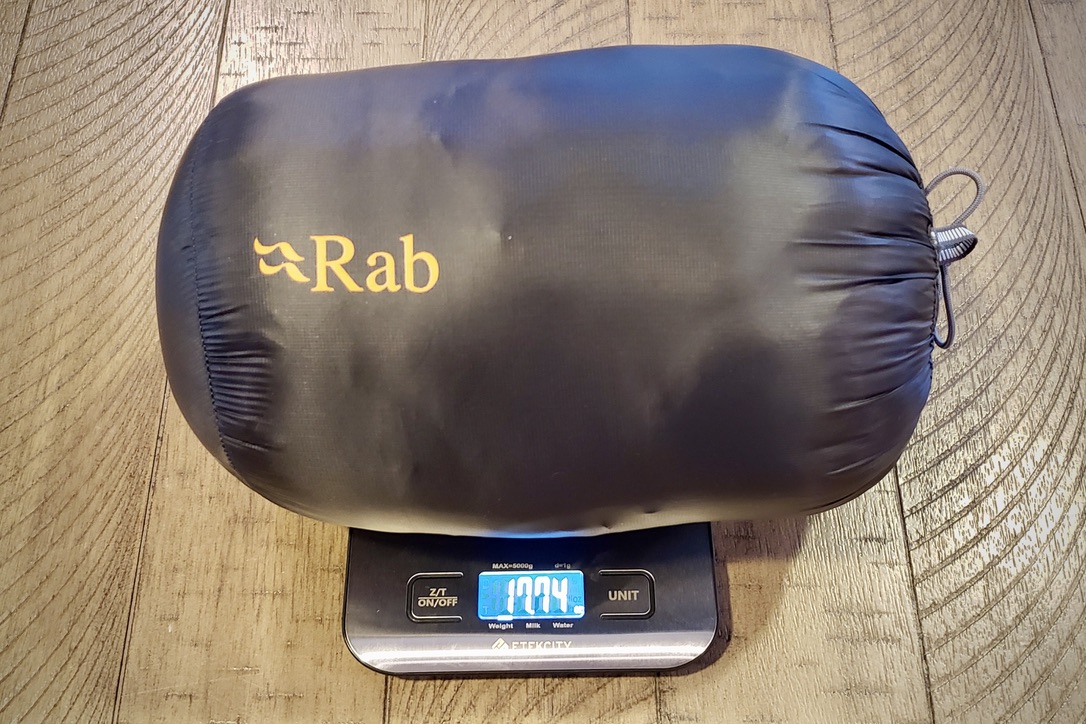

Super-lightweight down jackets typically come with a premium price tag, but the investment can be worthwhile for adventurers with limited space looking to trim ounces. Models like the Black Diamond Approach Hoody and Feathered Friends Eos strike a solid balance between lightweight simplicity and premium performance.
If speed and efficiency are of utmost importance, jackets like this won’t hold you back. Make sure to research the full range temperatures you will encounter on your trips before leaving, however, and don’t prioritize an ultralight base weight so much that you put yourself in danger.
Storing and Caring for Down Jackets
Some of these down jackets can compress to the size of a water bottle or smaller, while others are bulkier — influenced by the fill, face fabric, and overall design. A tiny pack size can allow you to carry a smaller, lighter load on lightweight excursions, but make sure to not leave your down jacket smushed up for long periods of time. This can greatly impact the down’s lofting and insulating abilities, and reduce the jacket’s overall lifespan.
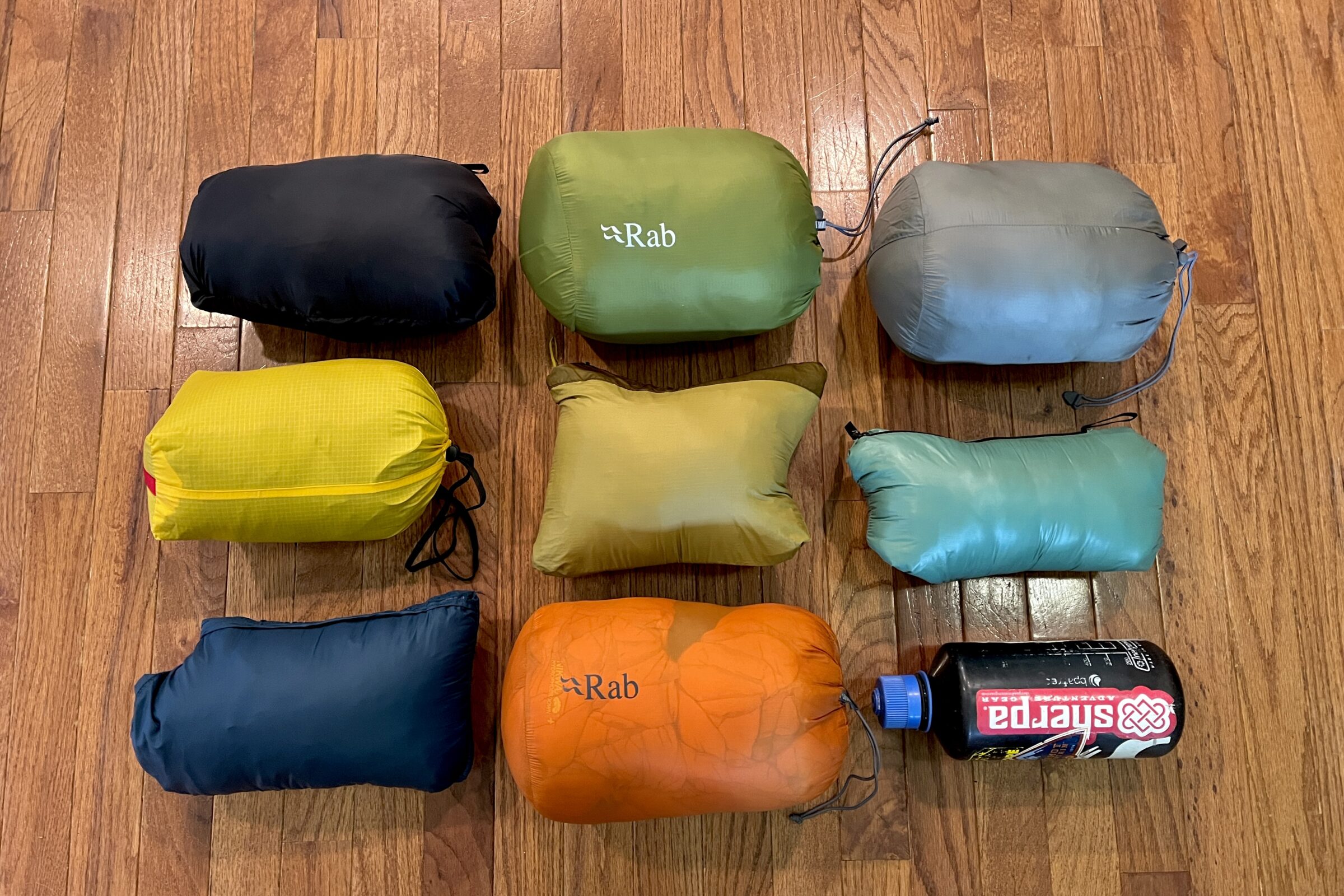

It’s fine to keep your jacket in its stuff sack for one or two days at a time, but try to pull it out of the sack regularly and let it loft up fully over the duration of your trip. When storing your jacket after you get home, hang it in your closet — and don’t mash it too tightly between your other clothes. Washing your jacket with down-friendly detergent can also prolong its life. We gravitate to Nikwax’s Down Wash Direct for this purpose.
Other Key Features
The finer details of a down jacket can have a big impact on performance. Look for helmet-compatible hoods or tall collars for weather protection, and wire-brimmed hoods for improved visibility in wind and snow. High-quality zippers (like YKK), adjustable hems, and secure cuffs — whether elastic, Velcro, or with thumb loops — help seal in warmth.
Most jackets include zippered hand pockets, often placed high for harness compatibility, along with chest or internal stash pockets. Some stuff into their own pocket for easy packing. Technical options may also offer pit zips, powder skirts, or two-way zippers for belaying.
These small features add up, especially when you’re active in the mountains or layering up for cold-weather missions.
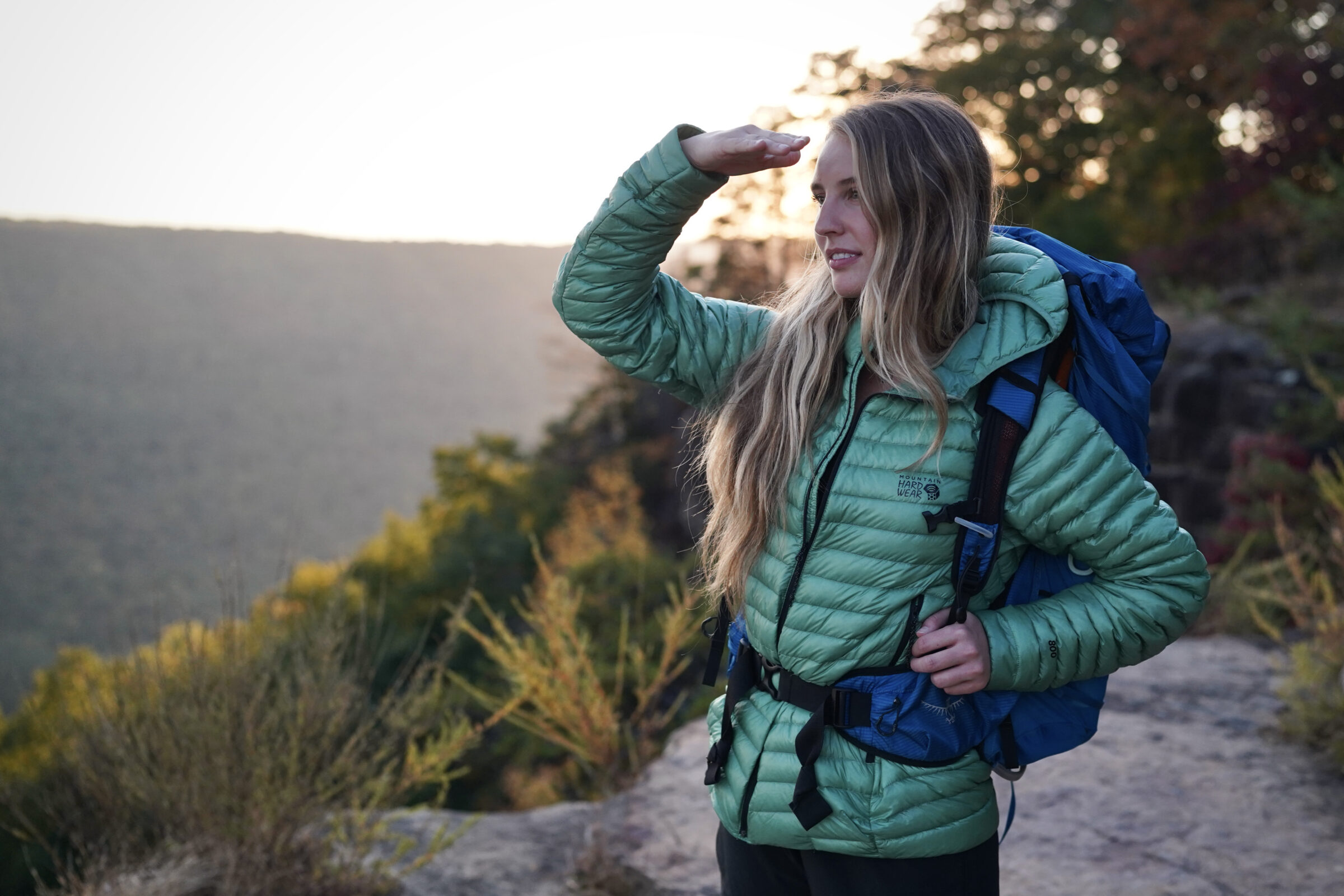

Price & Value
It’s easy to spend $250-500 on a down jacket. And that’s no small investment. The main thing to consider when looking at your budget is the end use.
Budget
There aren’t many options in this category. If you’re regularly packing into the backcountry, an ultralight, super-packable, rather expensive jacket may be necessary. If you’ll mostly wear it around town or for light trail use, something like the budget-friendly REI 650 Down Jacket will keep you warm for just over $100.
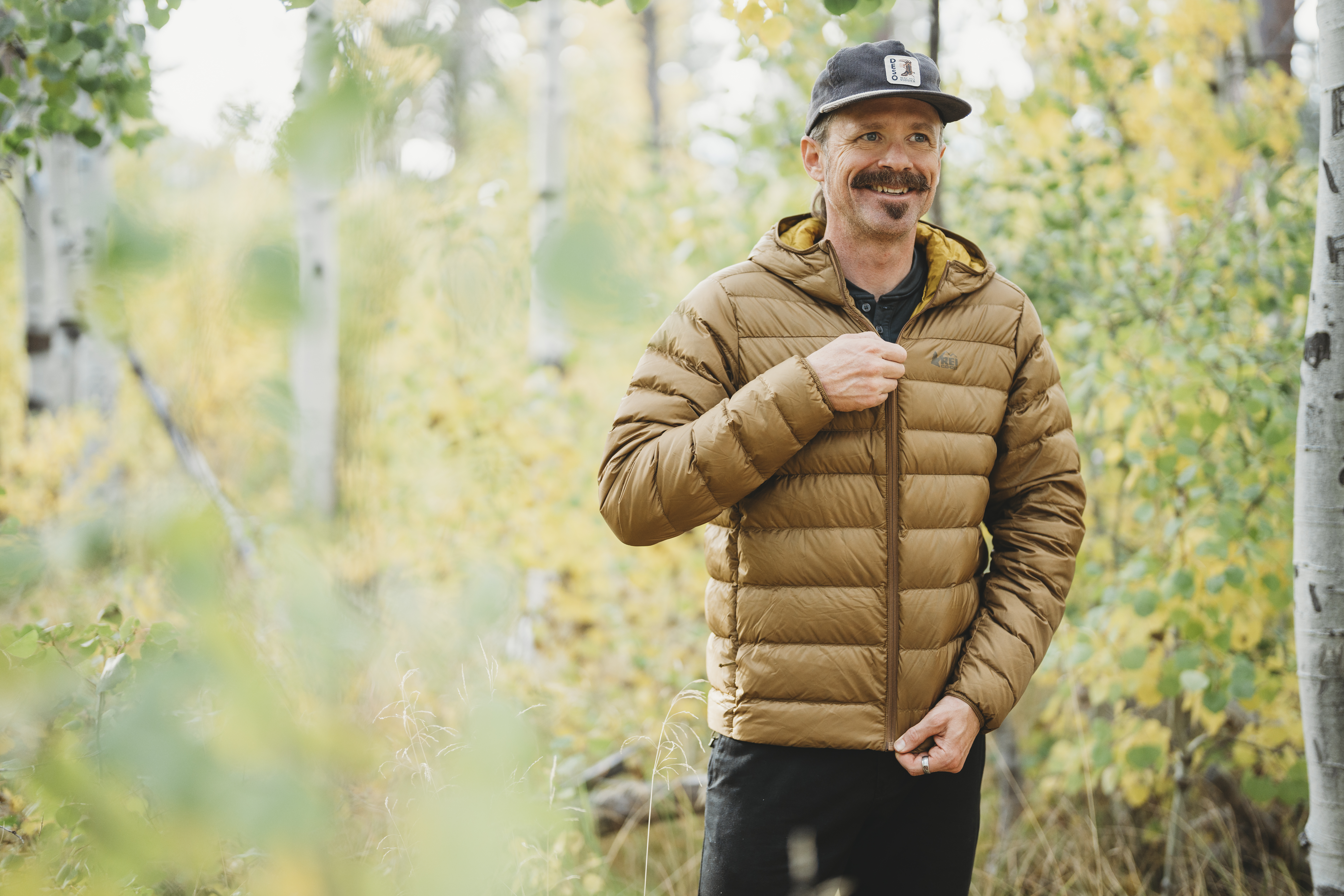

Mid-Tier
Most down jackets on our list range from $280 to $400. With this increase in price, you’ll typically see an increase in fill power and fill weight, which translates to an increase in warmth. Even our best warmth-to-weight ratio pick, the Black Diamond Approach Down Hoody ($380), and our warmest midweight, the Rab Neutrino Pro ($400) fall in this range.
Mid-tier jackets like our most durable pick, the Mountain Hardwear Stretchdown Hoody ($300), also have more features, including added pockets, adjustable hoods, weather-resistant materials, and more. While this may seem like a ton to pay for a jacket, with proper treatment, jackets in this tier should last long enough to be worth the investment.
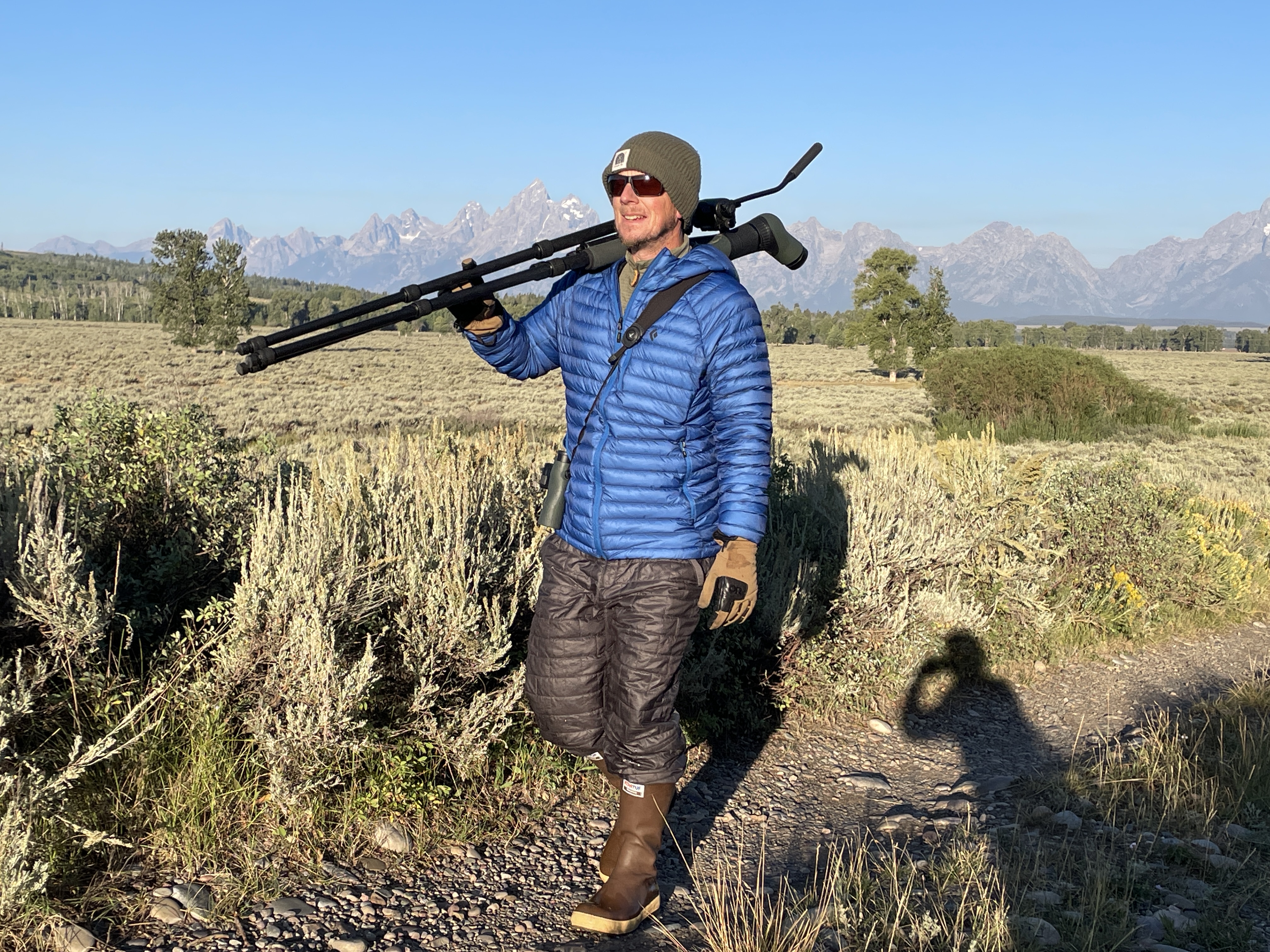

Premium
These jackets, which range from $409 and above, tend to be designed for adventures or expeditions in frigid temperatures. The Rab Mythic G Down Jacket ($525), the Rab Mythic Ultra ($495), the Arc’teryx Thorium ($500), and the Feathered Friends EOS ($409) have some of the highest fill powers on this list, which means they have an excellent warmth-to-weight ratio.
They are often weather-resistant and more durable, as well. However, if you’re going to throw down this much for a jacket, you’ll want to be sure you have the need for it. We typically grab these jackets atop high peaks in mid-winter before skiing down or when we’re tackling technical objectives in Nepal or Alaska. They’re also ideal for when you’re going to be stationary in freezing temps; think ice fishing, ice climbing, your kid’s football game in December, or belaying. An exception to this rule is the The North Face Summit Series Breithorn Hoodie ($430). It was a unicorn of sorts: light enough for moderate activity on cold days, but warm enough for standing around, too.
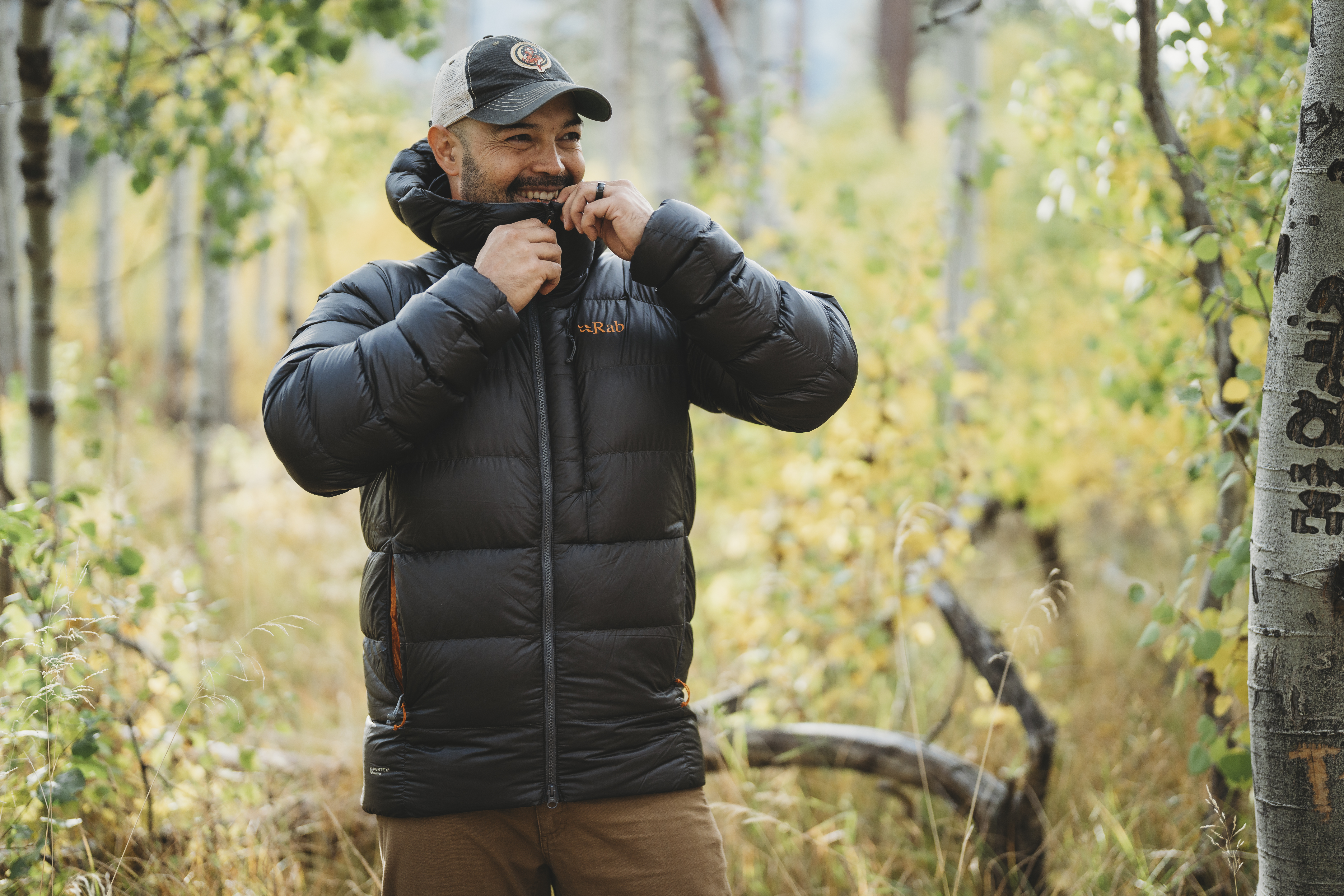

Frequently Asked Questions
A down jacket holds heat around your body’s core in order to maintain a comfortable level of warmth when the temperatures drop. A spectrum of down jackets exists from plush and stylish for everyday use to lighter, packable designs for year-round backcountry adventures.
A jacket’s fill power is the down’s quality and amount of loft. You’ll see jackets labeled as 600-fill or 800-fill, for instance. The fill weight, which we measure in ounces, reflects the density or amount of down stuffed inside the jacket.
So when two 700-fill jackets have different weights, we know the heavier one is warmer.
On the other hand, if two down jackets weigh the same with different fill power (two 15-ounce jackets with 650-fill and 800-fill), the higher fill jacket is going to be less bulky, lighter, and more compressible.
It’s tricky to compare jackets with differing fill power. But in general, the lower the fill power, the less loft and warmth.


Down jackets have a huge variance of warmth. Some jackets are constructed to withstand freezing or sub-zero temperatures, while others are a match for summer, spring, and fall backpacking trips. Here are the broad categories of jackets, depending on their fill weight:
- Lightweight: 3-4 ounces of down fill, three-season jacket, skiing midlayer
- Moderate weight: 5-6 ounces of down fill, more warmth for sub-freezing temperatures
- Heavyweight: More than 6 ounces of down fill, tenacious design for winter conditions
The combination of the fill weight and fill power, which is the loft and quality of the down, changes how warm a jacket is. The higher the fill power and higher the weight, the more heat the jacket retains.


Lightweight down jackets are very compressible and a great choice for cramming into your pack for emergency use. But they often cost more. Those weights range from close to 8 to 15 ounces. Midweight options bump up to the 20-ounce range, and heavier down jackets are around 30 ounces.
The best down jacket for you is based on where and how you’ll use it. If the weather is relatively dry and super cold, a down jacket with greater down fill that will retain more heat could be worth the investment. If you’ll be in a really wet environment, a synthetic down jacket might be a better choice.


As you search for a down jacket, pay attention to the fill power, overall fit, and price. Be sure the warmth and features match your needs, like whether or not the jacket has a helmet-compatible hood, underarm zippers, and harness-compatible hand pockets.
Examine the level of weather resistance, like DWR-treated material or down, and if it matches the exposure you’ll be in. Some jackets are even reinforced in high-use areas, like in the shoulders for pulling on and off a pack. If you plan on venturing into the backcountry, weight and compressibility make a difference, too.




We tested the best women’s down jackets, from hefty technical layers to lightweight puffers, including Rab, Patagonia, Mountain Hardwear, Arc’teryx, and more.

We tested the best synthetic insulated jackets from Arc’teryx, The North Face, Patagonia, and more to help you find the best option for your needs and budget.
Read the full article here




